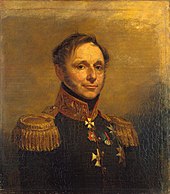Pyotr Kirillovich food
Pjotr Kirillowitsch Essen ( Russian Пётр Кириллович Эссен ; scientific transliteration Pëtr Kirillovič Ėssen ; born August 11, 1772 , † September 23, 1844 in Saint Petersburg ) was a Russian general and statesman. He came from a middle-class Baltic German family from Pärnu in what is now Estonia . Pyotr Kirillowitsch Essen was made count in 1833 .
Life
In May 1787, Essen joined the body cuirassier regiment of the imperial guard . He took part in the Russo-Swedish War 1788-90 and was promoted to sub-lieutenant on January 1, 1791. The other promotions came in quick succession: March 1793 lieutenant, September 1793 captain, September 1795 major, November 1796 lieutenant colonel, December 1796 colonel, and February 1798 major general and commander of the Musketeer regiment in Vyborg . In January 1800 he became lieutenant general and from August to December 1800 he was also military governor of Vyborg. He took part as regimental commander in the coalition wars of 1799/1800 and as a division commander in the coalition wars of 1805, 1806/07 and 1812/14 and in the Russo-Turkish wars 1806-12. In April 1807 he was awarded the 3rd Class Order of St. George for his bravery in the battle of Prussian Eylau against Napoléon on 7/8. February 1807.
In January 1817, Tsar Alexander I appointed him corps commander and military governor of the Orenburg region , an office he held until 1830. In 1819 he was promoted to general of the infantry. On February 7, 1830, Tsar Nicholas I appointed him military governor general of the Saint Petersburg governorate and in April of the same year a member of the State Council ; He held both offices until February 14, 1842. In 1830 he also became a member of the board of directors of the “Department of the Institutions of Tsarina Maria”, which, on behalf of Tsar's mother Maria Feodorovna , endeavored to expand educational and charitable institutions. In 1831 he also became chairman of the anti-cholera committee (he himself had almost died of cholera during the so-called "cholera mutinies" in spring 1831 ). On July 1, 1833, the Tsar made him imperial count, and in April 1834 he was awarded the Order of St. Andrew , the highest Russian order; he received the diamonds for it in April 1841. In Saint Petersburg he introduced regulations according to which companies that manufactured dangerous products or by-products were only allowed to settle on the lower reaches of the Neva and its side canals.
Awards
In addition to the Order of St. Andrew with diamonds and the Order of St. George, Essen received a number of other important Russian orders, including the following:
- Order of Saint Anne 3rd Class January 1798; 2nd class May 1798; 1st class with diamonds October 1799
- Order of St. Vladimir 2nd class February 1808; 1st class February 1812.
- Alexander Nevsky Order December 1809; Brilliants August 1811
- Order of the White Eagle April 1834
King Friedrich Wilhelm III. von Prussia awarded him the Order of the Red Eagle 1st Class (1807) and Friedrich Wilhelm IV. the Order of the Black Eagle (June 1842).
End and offspring
Count Essen withdrew from public life in December 1842. He died on September 23, 1844.
The only child from his marriage to Katharina Lwow, the daughter Alexandrine (1816–1868), married Count Karl Jakob Pontus Stenbock -Fermor (1806–1866); In 1835 the Tsar allowed them to name themselves and their descendants Essen-Stenbock-Fermor.
Individual evidence
- ↑ Герб графа Эссен
- ^ "Essen, bourgeois family in Pernau", in Genealogical Handbook of the Baltic Knighthoods , Part 2, Estonia, Volume 1.2, Verlag für Kippenforschung und Wappenkunde CA Starke, Görlitz, 1930, p. 69 online
- ↑ Genealogical Handbook of the Baltic Knights , Part 1, Livonia, Volume 2, Görlitz, 1929, p. 689 online
- ^ Carl Arvid von Klingspor : Baltic Wappenbuch. Coats of arms of all noble families belonging to the knights of Livonia, Estonia, Courland and Oesel . Stockholm 1882, p. 74 online
literature
- Яков Ноевич Длуголенский: Военно-гражданская и полицейская власть Санкт-Петербурга. 1703-1917. Нева, Санкт-Петербург 2001, ISBN 5-87516-215-5 , pp. 112–118, (Russian).
Web links
- Baltic Historical Commission (ed.): Entry on Pyotr Kirillowitsch Essen. In: BBLD - Baltic Biographical Lexicon digital
- Pyotr Kirillowitsch Essen in the online encyclopedia Saint Petersburg (English, Russian )
- ЭССЕН (3-й) Петр Кириллович (11.08.1772 - 23.09.1844) граф (с 01.07.1833), генерал от инфантерии (1819) on Internet project 1812, (1812, Russian army, generals)
| personal data | |
|---|---|
| SURNAME | Food, Pyotr Kirillovich |
| ALTERNATIVE NAMES | Эссен, Пётр Кириллович (Russian); Ėssen, Pëtr Kirillovič (scientific transliteration) |
| BRIEF DESCRIPTION | Russian general, count and statesman |
| DATE OF BIRTH | August 11, 1772 |
| DATE OF DEATH | September 23, 1844 |
| Place of death | St. Petersburg |

